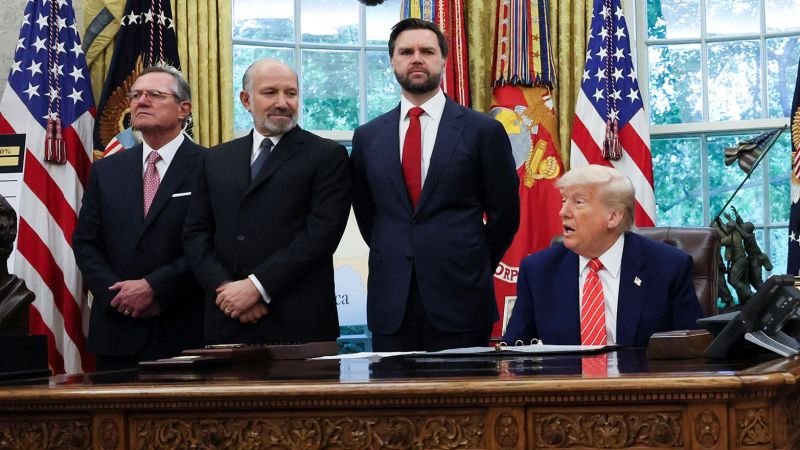In a significant development in international trade relations, President Donald Trump has announced an initial framework for a trade agreement between the United States and the United Kingdom. While it’s important to clarify that this announcement is not a traditional trade deal, but rather a foundational outline for future negotiations, it marks a crucial step in Trump’s ongoing trade agenda. The agreement signals an intention for discussions that could last several months or even years, ultimately aimed at establishing a comprehensive agreement that may enhance trade benefits for the United States compared to the current landscape.
The sentiment surrounding this announcement is largely positive among Trump’s supporters, as it provides a sense of achievement amidst a challenging trade environment. U.K. Prime Minister Keir Starmer, when questioned about the improvement in trade relations since the commencement of Trump’s presidency, emphasized the need to consider whether this new framework is better than previous circumstances. There are indications that it is indeed perceived favorably; initial assessments suggest that tariffs on certain British goods will be reduced, potentially opening up the U.K. market for additional American goods.
As Trump continues to navigate negotiations, a looming deadline weighs heavily on his administration. A critical date is July 8 when punitive tariffs, which can soar as high as 50% on imports from various countries, are set to be reinstated. This scenario heightens the urgency for the administration to finalize more than a hundred trade agreements. Trump remains optimistic about reaching these targets, asserting that he has already completed a significant volume of trade deals—though he has clarified that many of these are still pending.
However, skepticism remains about the viability of quickly executing such a number of agreements. The sluggish pace traditionally associated with international trade negotiations raises concerns, particularly regarding a potential deal with China, one of the United States’ most critical trading partners. Presently, trade between the U.S. and China has seen a dramatic downturn, with average tariffs exceeding 145% on most Chinese imports, while a 125% retaliatory tariff has been imposed on U.S. goods. These barriers have effectively stalled trade.
Amidst increasing concerns, U.S. and Chinese trade officials are scheduled to convene in Geneva for negotiations. Treasury Secretary Scott Bessent expressed doubts about reaching any definitive agreement but hopes for a move towards de-escalation. Trump, however, remains firm in his stance on tariffs, refusing to lower them ahead of potential discussions, which China has stated is a prerequisite for talks.
Back on home soil, critics caution that the Trump administration’s steadfast trade policies have dramatically escalated tariff levels, pushing the effective rate on imports well above 22%. This figure is exceptionally high compared to other developed nations and has notably impacted the U.S. economy. Recent data revealed an unexpected contraction in gross domestic product (GDP), primarily driven by businesses stockpiling goods in anticipation of rising tariffs. This decline signals growing adversity within a previously healthy economy.
Such economic repercussions are particularly concerning as they occur even before the full implementation of Trump’s aggressive trade strategies. Many commentators emphasize that real trade agreements take time and encompass intricate details, which often involve protecting various political interests tied to specific sectors.
In this context, the UK’s recently agreed-upon framework can largely be viewed as an initial memorandum of understanding rather than a fully realized trade pact. While it may result in immediate tariff reductions, its long-term impact on the economy remains uncertain. Experts point out that the short respite provided by the tariff pause is insufficient to facilitate meaningful discussions, thus highlighting the gap between mere verbal agreements and concrete, binding trade agreements with their necessary long-term ramifications.
The market, in response to the announced agreement between the U.S. and the U.K., reacted positively, signaling investor relief and hope for stability. Nonetheless, as analysts underscore, the focus of utmost importance remains on the negotiations with China. The ongoing tariff issues have led to significant disruptions, with anecdotal evidence suggesting potential shortages and price increases reminiscent of pandemic-related supply chain scenarios, according to logistics firms.
Importantly, the long-term sustainability of these high tariffs remains contentious, with Bessent pointing out that they may ultimately prove to be unmanageable. The expectation is that substantial reductions are necessary for effective trading to resume. However, experts predict a significant time lag in recovery, indicating that trade normalization with China could take multiple years even after initial agreements are struck.
In conclusion, while Trump’s administration touts its recent accomplishments in international trade negotiations, the broader challenges and significant hurdles surrounding key trade partners like China are poised to overshadow such developments. The viability of the agreement with the U.K. serves as a glimmer of hope, but the pressing question remains whether it can contribute to a stable and fruitful trading landscape in the face of ongoing disputes and tariffs worldwide.



